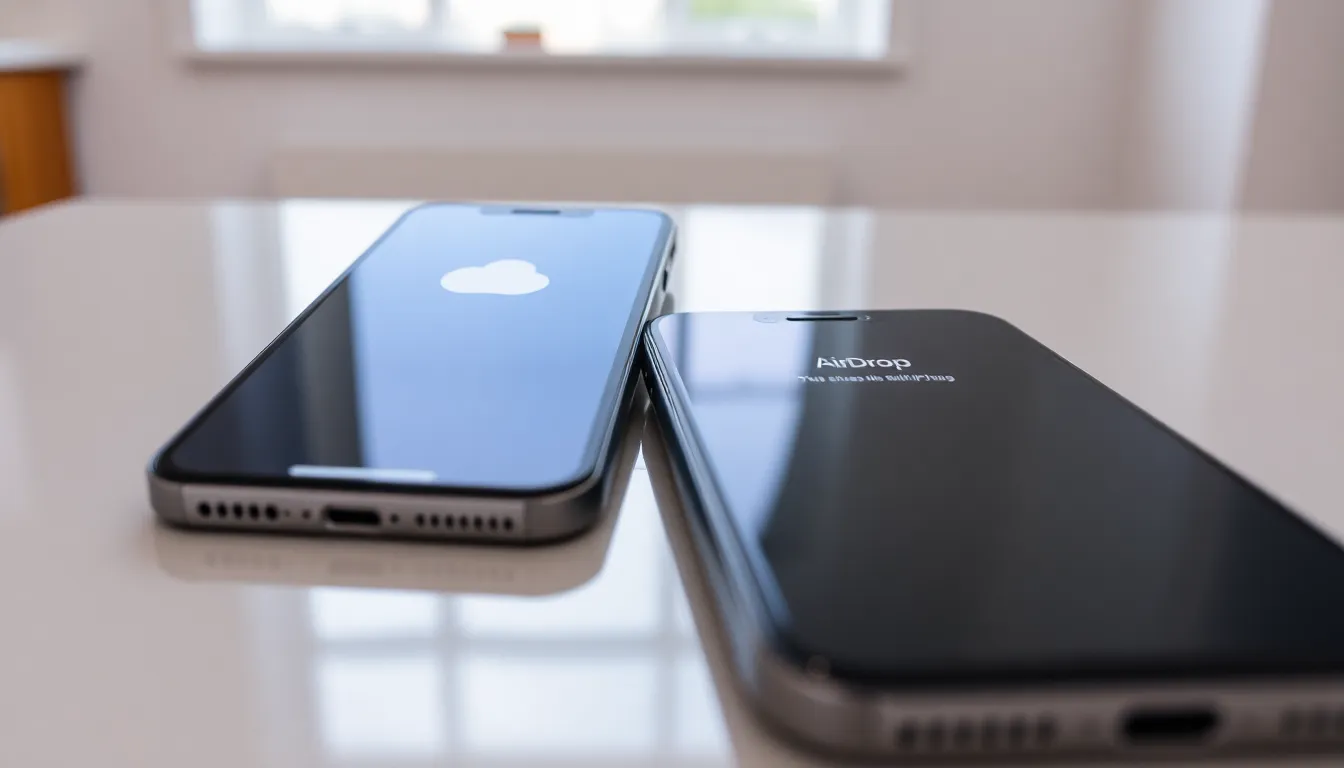Table of Contents
ToggleTransferring information between iPhones can feel like trying to solve a Rubik’s Cube blindfolded. But fear not, tech-savvy friends! Whether you’re sharing photos from last weekend’s epic brunch or handing over that must-have playlist, passing data between devices doesn’t have to be a headache.
With a few simple tricks up your sleeve, you’ll be zipping files and sharing memories faster than you can say “AirDrop.” This guide will walk you through the most effective methods to transfer everything from contacts to cherished family photos. So grab your iPhone, and let’s dive into the world of seamless sharing—because who wouldn’t want to make their digital life a little easier?
Overview of Information Transfer Between iPhones
Transferring information between iPhones involves several effective methods tailored for various data types. Users can share photos, music, contacts, and more with ease when following the right procedures. Apple devices support a range of built-in features that simplify this process.
AirDrop offers a quick, wireless way to send files between iPhones. It’s particularly useful for sharing photos or videos instantly. Both iPhones must be nearby, with Bluetooth and Wi-Fi enabled for AirDrop to function properly.
iCloud provides another reliable option for information transfer. When users back up their data to iCloud, they can sync it across devices seamlessly. After signing into the same Apple ID, accessing contacts, calendars, and notes becomes straightforward.
For larger data transfers, using iTunes or Finder can be advantageous. Through a USB connection, users can transfer files directly from one iPhone to another. This method allows for a more controlled transfer of specific files, ensuring no unnecessary data is included.
Additionally, third-party applications exist for transferring information. Various apps support specific types of content, giving users flexibility based on their needs. These applications often provide detailed instructions to streamline the transfer process.
Understanding these methods empowers users to share information confidently. By choosing the right technique, transferring data from one iPhone to another becomes a less daunting task. Utilizing these options enhances the digital sharing experience, making it more efficient and user-friendly.
Methods to Pass Information

Multiple effective methods exist for transferring information between iPhones, making the process efficient and straightforward.
Using AirDrop
AirDrop enables quick sharing of files without the need for cables. Both iPhones must have Bluetooth and Wi-Fi activated for this feature to work. To share, open the desired content, select the Share icon, and choose the recipient’s device. Accepting the transfer on the other iPhone completes the process within seconds. AirDrop is particularly suitable for sending images and documents in real-time.
Using iCloud
iCloud serves as a robust backup solution, offering seamless data synchronization across devices. By backing up to iCloud, users can access shared content like photos, contacts, and calendars on multiple iPhones. To use iCloud, ensure both iPhones are signed in to the same Apple ID. Activate iCloud in the Settings menu and select which types of data to sync. This method simplifies long-term sharing of various content types.
Using iTunes
iTunes facilitates larger transfers of specific files through a direct USB connection. Users can connect one iPhone to a computer and open iTunes or Finder. Selecting the device icon allows access to syncing options for music, videos, apps, and more. After choosing the desired content, initiate the sync process. This method efficiently manages significant data transfers with total control over shared materials.
Using Third-Party Apps
Various third-party apps streamline data transfer between iPhones, offering specialized solutions for different content types. Users can explore applications like SHAREit, Move to iOS, and Send Anywhere for flexible sharing options. Each app provides a user-friendly interface and step-by-step instructions. By using these tools, users gain additional choices for sharing files such as videos, apps, and documents across devices.
Step-by-Step Guide for Each Method
Discover effective processes for transferring information between iPhones. Users can choose from convenient options like AirDrop, iCloud, iTunes, or third-party apps based on their needs.
AirDrop Transfer Process
Initiate the transfer by ensuring both iPhones are near each other. Enable Bluetooth and Wi-Fi on both devices. Open the content, select the Share icon, then tap on the recipient’s device name in the AirDrop menu. Confirmation appears on the recipient’s iPhone, allowing them to accept the transfer. Completed transfers show the files directly in the appropriate app, making document access effortless.
iCloud Transfer Process
Begin by backing up data to iCloud from the source iPhone. Go to Settings, tap on the user name, select iCloud, and enable backup options. After backing up, sign in with the same Apple ID on the target device. Access the iCloud settings on the new iPhone to enable data syncing for photos, contacts, and apps. The transferred content automatically becomes available on the new device, enhancing synchronization.
iTunes Transfer Process
Connect the source iPhone to a computer using a USB cable. Launch iTunes (or Finder on macOS Catalina and later). Select the device icon in the software, then choose the content you want to transfer. Click on the “Sync” button to initiate the transfer process. Once syncing finishes, disconnect the source device and connect the target iPhone to the computer. Select the device again and sync the same content to the new iPhone for a seamless transfer experience.
Third-Party Apps Transfer Process
Download third-party applications like SHAREit, Move to iOS, or Send Anywhere on both devices. Open the selected application and follow the in-app instructions. Usually, users create a direct connection via Wi-Fi or a QR code scan. Send the required files from the source iPhone and accept them on the target device. These apps typically offer additional features, allowing users to transfer various data types quickly and efficiently.
Tips for a Smooth Transfer
Ensure both iPhones are updated to the latest iOS version for compatibility. Prioritize a strong Wi-Fi connection when using AirDrop or iCloud. Keep devices close enough to maintain a stable Bluetooth connection during file sharing. Familiarize yourself with the transfer methods outlined earlier to select the best one.
Choose AirDrop for quick transfers of photos, videos, or documents. Users can enhance this method’s speed by disabling any unnecessary apps running in the background. Utilize iCloud for seamless syncing of contacts, calendars, and additional content. Signing in with the same Apple ID on both devices simplifies the process.
Employ a USB connection for larger transfers using iTunes or Finder. This method provides control over which data is selected for transfer, ensuring no unwanted files are moved. Third-party applications can offer specialized features for specific data types. Research various apps to find one that meets individual needs for versatility and ease of use.
Consider backing up the source iPhone to iCloud before transferring data. This backup creates a safety net, preventing potential data loss during the transfer process. Verify that all desired content is included in the backup for a smooth transition.
Lastly, stay patient during the transfer process. Larger files may take additional time, so avoiding interruptions will ensure successful completion. Following these tips enhances the overall transfer experience, making it straightforward and efficient.
Transferring information between iPhones doesn’t have to be a daunting task. With various methods available users can easily share files and sync data without hassle. Whether opting for AirDrop for quick transfers or iCloud for seamless syncing each method offers unique advantages tailored to different needs.
By following the outlined steps and keeping devices updated users can ensure a smooth transfer experience. Emphasizing the importance of backing up data further safeguards against potential loss. With a bit of patience and the right approach sharing information between iPhones becomes a straightforward process that enhances digital connectivity.




